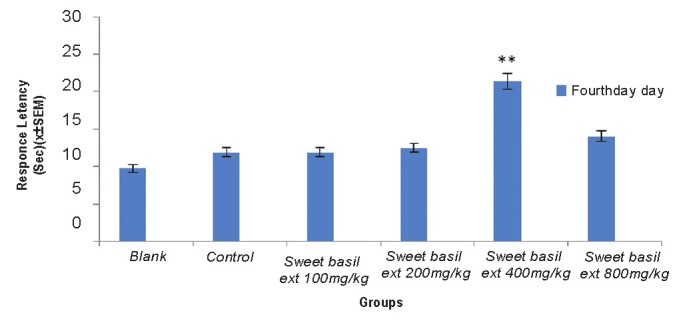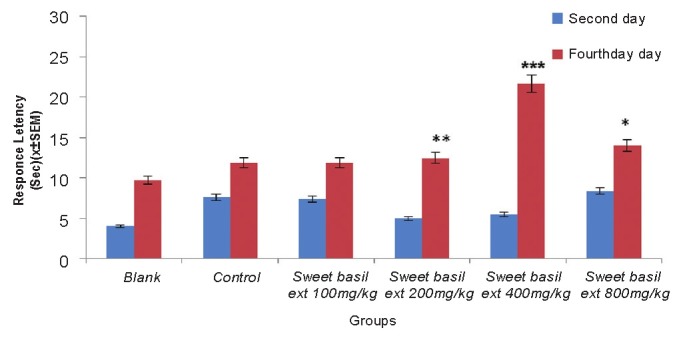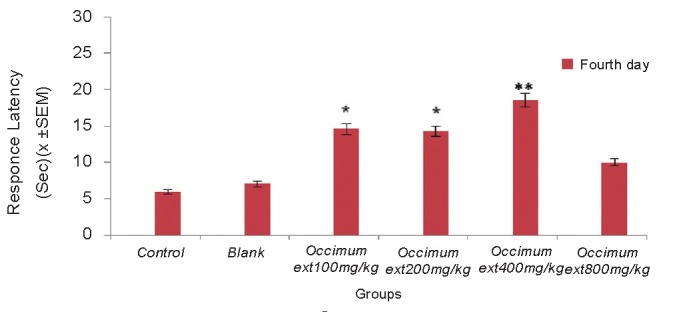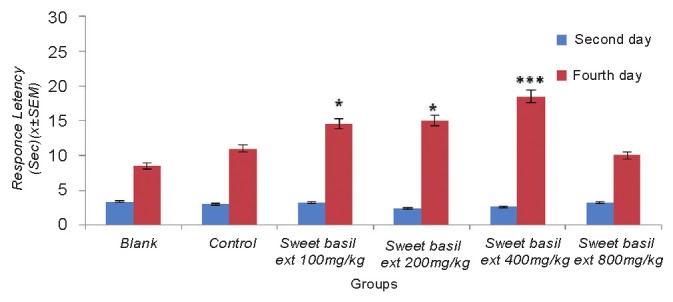Abstract
The purpose of this study was evaluation of green Ocimum basilicum (sweet basil) hydroalcoholic extract on memory retention and retrieval of mice by using passive avoidance apparatus. For this purpose, after weighting, coding and classifying the mice, they were grouped (n = 8) as follow as: test groups (electric shock plus sweet basil extract by doses: 100, 200, 400 and 800 mg/kg, i.p.), control group (Only electric shock) and blank group (electric shock plus normal saline). In all mentioned groups delay time of leaving the platform for both retention and retrieval test of memory was measured. In retention test, sweet basil extract was administered immediately after receiving electric shock and in retrieval test it was administered 24 hours after receiving electric shock. The results indicated that hydroalcoholic extract of green Ocimum basilicum significantly (P < 0.05) increased memory retention. The best response was achieved with 400 mg/Kg of the extract. Also, results showed that sweet basil extract significantly (P < 0.05) increased memory retrieval and the best result was achieved with 400 mg/Kg too. It can be concluded that memory enhancing effects of green Ocimum basilicum is because of antioxidant activity of flavonoids, tannins and terpenoids.
KEY WORDS: Memory retention, memory retrieval, mice, green Ocimum basilicum, passive avoidance
INTRODUCTION
Memory is an important function in the brain, and is the ability of an individual to record information, retain and recall them whenever needed and more over, use of this information to adapt the responses to environment hence it is vital for survival.[1]
Memory and learning are long-lasting modifications in central nervous system and involve activation by some neurotransmitters, such as acetylcholine, dopamine, and serotonin.[2]
There are several evidences of epidemiological researches that show significant correlation between dietary intake of vegetables and cognitive function improvement in elderly people. For example, aging women who consume cruciferous vegetables showed less cognitive decline than the others that didn't eat them.[3]
Medicinal plants have been primary source of medicines and are rich sources of secondary metabolites and oils that are important in therapeutics. The most important advantage of them is their low price and availability worldwide beside their safety.[4] So, among a lot of self-medication worldwide which is considered a sa terrible problem for health system,[5–8] self-medication with plants is safer and has been done worldwide for decades.[9]
Sweet basil (Ocimum basilicum L.) a member of Lamiaceae is an aromatic, herbaceous, autogamous plant that is annual and perennial.[10] This plant is 20-60 cm long, white-purple flowering plant, and is originally native to India and other regions of Asia and also Africa, South America, and the Mediterranean but widely cultivated in many countries.[11,12] sweet basil is used in Mediterranean cuisine and foods such as soup, cream cheese for sandwiches and pasta dishes,[13,14] and in Iran as vegetable and food flavoring.[15] Also Combination of Umbilicus intermedicus, Rumex and Ocimum leaves are used in treatment of burn in some western states of Iran.[16]
Different varieties of this plant has been recognized as a medicinal plant in folk medicine from ancient time.[17] Sweet basil is used as cardiotonic, abdominal pain reliever, anti-diarrhoea medicine, hypolipidemic plant hypoglycemic agent, anti-inflammatory and anti-oxidant.[13] More over it has been traditionally used for treatment of a variety of neurological disorders such as anxiety, headaches and migraines, nerve pains, inflammation, cough, cold, digestive disorders, chest and lung complaints, fever, insect bites, menstrual cramps, sinusitis and as carminative and antispasmodic.[15,18]
Based on the mentioned evidences, we conducted the present study to assess the effect of hydroalcoholic extract of green Ocimum basilicum on retention and retrieval of memory in mice and to determine its possible mechanism of action.
MATERIALS AND METHODS
Animals
Male albino NMRI mice weighing 20-25 g were used throughout the study. The animals were obtained from Pasture Institute (Tehran, Iran) and were kept in an animal house with a 12-h light/12-h dark cycle and controlled temperature (22 ± 1°C) with relative humidity of 45-55%. They were housed in groups of 8 in Plexiglas animal cages and were given free access to food (Pars Khorakdam, Shushtar, Iran) and tap water. All experiments were performed between 8:00 a.m. and 2:00 p.m. from May to August, 2010 in Qom University of Medical Sciences, School of Medicine and each animal was used once. The experimental protocol was carried out in accordance with the Research and Ethics Committee of Qom University of Medical Sciences.
Plant material and preparation of extracts
Leaves of green Ocimum basilicum were purchased from a grocery in Tehran, Iran and identified at Traditional Medicine and MateriaMedica Research Center herbarium, ShahidBeheshti University of Medical Sciences, Tehran, Iran. The leaves were allowed to dry in shadow until desiccated. The dried leaves were crushed into powderand stored at room temperature in appropriate container. 100 g of the powder was extracted using ethanol 80% (v/v) by maceration. The extract was separated and filtrated by Watman filter papers. The prepared extract was concentrated by vacuum evaporation and then it was dried in low temperature.
Preparation of doses
The doses of 100, 200, 400 and 800 mg/Kg of the hydroalcoholic extract of green Ocimum basilicum were used. Doses were selected on the basis of dry weight of extract and sodium chloride 0.9% was used as solvent. All doses were intraperitoneally administered as mentioned in passive avoidance test.
Passive avoidance test
Two groups of animals used for retention and retrieval experiments. Each group subsequently divided into six sub-groups (each of 8 animals). The first to fourth groups received sweet basil extract 100, 200, 400 and 800 mg Kg-1, respectively. The fifth group received normal saline (1 ml/100 g) as (Blank) group and the sixth group was untreated control. Each animal was used only once.
Step-down latency in passive avoidance is a suitable test for memory in mice.[19]
The step-down apparatus used to test passive avoidance, consisted of a Plexiglas box (25 × 25 × 30 cm3) with a floor that consisted of parallel stainless steel rods (0.3 cm in diameter, spaced 1 cm apart). There was a round Plexiglas platform 1cm high and 9 cm in diameter which could be enclosed by a 20 cm long hollow glass cylinder with an inner diameter of 10 cm. Electric shocks (1 Hz, 0.5 s and 45VDC) were delivered to the grid floor by an isolated stimulator (Pashmforush Co, Ahwaz, Iran).
On first day, groups of 4 animals were given access to learning apparatus for 3 min to familiarize them with the new environment. On second day, the mice were individually placed on the round Plexiglas platform inside the cylinder. After 10 seconds the cylinder was removed and the step-down latency was measured. Animals that had latencies longer than 30 sec were discarded.[20] On third day, the same procedure was followed as on second day, except that a 1 sec foot shock (1 mA) was administered as soon as the animals left the platform with all 4 legs. For studying the effects of Ocimum basilicum on memory retention, the animals were injected (ip.) with normal saline or Ocimum extract immediately after foot shock and on fourth day, the mice step-down latency was measured.
For memory retrieval study, anything was injected to mice on third day of study while on fourth day, normal saline or sweet basil extract were intraperitoneally injected 30 minutes before mice step-down latency test.
Statistical analysis
Results are expressed as means ± SEM. The data were analyzed using one-way ANOVA followed by LSD test. Calculations were performed using the SPSS statistical package (SPSS Inc., Chicago, Illinois, USA) for windows version 19, and a difference with P < 0.05 between the experimental groups was considered statistically significant.
RESULTS
Effect of hydroalcoholic extract of green Ocimum basilicum L. on memory retention
Figure 1 shows the effects of hydroalcoholi cextract of green Ocimum basilicum (100, 200, 400 and 800 mg/Kg ip.) on memory retention in the passive avoidance step down test in 4th day of study.
Figure 1.

Comparison of step down latency on 4th day in mice re-ceiving sweet basil extract (100, 200,400 and 800 mg/Kg), normal saline and untreated in memory retention test. Significant difference between day 4 of extract groups with control is shown as **P < 0.01. Control: No injection, Blank: Normal saline (1 mL/100g). Data are mean ± SEM. (n = 8)
A one-way ANOVA revealed that Ocimum extract significantly (P < 0.05) increased step-down latency in passive avoidance task. Post hoc analysis by LSD indicated that 400 mg/Kg extract is the most dose as memory retention enhancer Figure 1.
Figure 2, shows comparison of step-down latency between 2nd and 4th day in mice, received Ocimum extract (100, 200, 400 and 800 mg/Kg ip.), normal saline and untreated group, in memory retention test.
Figure 2.

Comparison of step down latency between day 4 and day 2 in mice received sweet basil extract (100, 200, 400 and 800 mg/Kg), Normal saline and untreated in memory retention test. Significant difference between day 2 and 4 is shown as ***P < 0.001, **P < 0.01 and *P < 0.05. Control: No injection, Blank: Normal saline (1 mL/100 g), Data are mean ± SEM. (n = 8)
A one-way ANOVA showed that sweet basil extract significantly (P < 0.05) increased step-down latency on day 4 in comparison with day 2, indicating memory retention enhancer. Post hoc analysis by LSD revealed that intraperitoneal administration of Ocimum extract (200 and 400 mg/Kg) significantly (P < 0.05) increased step-down latency on 4th in comparison with 2nd day.
Effect of hydroalcoholic extract of green Ocimum basilicum L. on memory retrieval
Figure 3 reveals the effects of hydroalcoholic extract of green Ocimum basilicum (100, 200, 400 and 800 ip. mg/Kg) on memory retrieval in the passive avoidance step down test, in 4 th day of study.
Figure 3.

Comparison of step down latency on 4th day in mice receiving sweet basil extract (100, 200,400 and 800 mg/Kg), normal saline and untreated in memory retrieval test. Significant difference between day 4 of extract groups with control is shown as **P < 0.01 and *P < 0.05. Control: No injection, Blank: Normal saline (1 mL/100 g). Data are mean ± SEM. (n = 8)
A one-way ANOVA showed that Ocimum extract significantly (P < 0.05) increased step-down latency in passive avoidance task. Post hoc analysis by LSD indicated Ocimum extract (100, 200 and 400 mg/Kg) increases retrieval of memory and 400 mg/Kg of extract is the most effective dose as memory retrieval enhancer.
Figure 4, reveals comparison of step-down latency between 2nd and 4th day in mice, received Ocimum extract (100, 200, 400 and 800 mg/Kgip.), normal saline or untreated group.
Figure 4.

Comparison of step down latency between day 4 and day 2 in mice received sweet basil extract (100, 200, 400 and 800 mg/Kg), Normal saline and untreated in memory retrieval test. Significant difference between day 2 and 4 is shown as ***P < 0.001 and *P < 0.05. Control: No injection, Blank: Normal saline (1 mL/100 g), Data are mean ± SEM. (n = 8)
A one-way ANOVA showed that Ocimum extract significantly (P < 0.05) increased step-down latency on 4th day in comparison with 2nd day, indicating memory retrieval enhancer. Post hoc analysis with LSD revealed that intraperitoneal administration of Ocimum extract (100, 200 and 400 mg/Kg) increased step-down latency on 4th day in comparison with 2nd day. While the 800 mg/Kg of extract didn’t significantly (P > 0.05) increase memory retrievalon 4th day in comparison with 2nd day of study.
DISCUSSION
Ageing and age-related neurodegenerative disorders such as Alzheimer are associated with behavioral impairment that causes significant morbidity. The most important candidates responsible for producing the neuronal changes mediating these problems are free radicals and the oxidative stress.[21]
Preventing formation of free radicals or removing them may be beneficial in prevention and treatment of neurodegenerative disorders.[22]
Green Ocimum basilicum hydroalcoholic extract was used in passive avoidance step down model to evaluate memory retention and retrieval of mice. The results obtained in the present study show that different doses of green O. basilicum increased memory retention and retrieval significantly (P < 0.05).
Our findings are in agreement with earlier studies on other spices of Ocimum. Dokania et al. (2011)[23] revealed that i.p injection of O. sanctum water extract enhanced memory in mice by its antioxidant activity. It has also been reported that O. sanctum hydroalcoholic extract enhanced memory in restraint stress induced memory impaired rats,[24] also, O. tenuiflorum ethanol extract increased step-down latency significantly.[25]
Further, We know that ethyl acetate extract of O. basilicum administration before global cerebral ischemia prevents cerebral ischemia-induced impairment of short-term memory[18] and this plant is effective in reducing oxidative damage which is attributed to its anti-oxidant properties.[26]
Literature surveys have showed that O. basilicum contains a high level of antioxidant activity,[27] which is attributed to the terpenoids, polyphenols and flavonoids like quercetin, kaempferol and myricetin; tannins like catechin,[11] and essential oil like eugenol and methyl chavicol.[28]
On the basis of results of this study, we believe that improvement of memory retention and retrieval by sweet basil extract may be due to the presence of antioxidants such as terpenoids, flavonoids and tannins, and their property to scavenge reactive oxygen species. So we suggest that O. basilicum could be useful clinically in improvement of memory.
In conclusion, this study provides experimental evidence for O. basilicum as an agent which improves memory and emphasizes the need to understand more fully the neuropharmacological effects of O. basilicum.
ACKNOWLEDGEMENTS
The authors would like to thank Mis Behnaz Keramatian for her kind help in preparation of the extract.
Footnotes
Source of Support: Nil.
Conflict of Interest: None declared.
REFERENCES
- 1.Alikatte KL, Aakondi BR, Yerragunta VG, Veerareddy PR, Palle S. Antiamnesic activity of Syzygium cumini against scopolamine induced spatial memory impairments in rats. Brain Dev. 2012;34:844–51. doi: 10.1016/j.braindev.2012.02.008. [DOI] [PubMed] [Google Scholar]
- 2.Kim DH, Yoon BH, Kim YW, Lee S, Shin BY, Jung JW, et al. The seed extract of Cassia obtusifolia ameliorates learning and memory impairments induced by scopolamine or transient cerebral hypoperfusion in mice. J Pharmacol Sci. 2007;105:82–93. doi: 10.1254/jphs.fp0061565. [DOI] [PubMed] [Google Scholar]
- 3.Rubio J, Qiong W, Liu X, Jiang Z, Dang H, Chen SL, et al. Aqueous extract of black maca (Lepidium meyenii) on memory impairment induced by ovariectomy in mice. Evid Based Complement Alternat Med. 2011;2011:253958. doi: 10.1093/ecam/nen063. [DOI] [PMC free article] [PubMed] [Google Scholar]
- 4.Singh V, Amdekar S, Verma O. Ocimum sanctum (tulsi): Bio-pharmacological activities Webmed central pharmacology. 2010;1 WMC001046. [Google Scholar]
- 5.Sarahroodi S. Self-medication: Risks and benefits. Int J Pharmacol. 2012;8:58–9. [Google Scholar]
- 6.Sarahroodi S, Arzi A. Self-medication with antibiotics, is it a problem among Iranian College students in Tehran. J Biol Sci. 2009;9:829–32. [Google Scholar]
- 7.Sarahroodi S, Arzi A, Sawalha A, Ashtarinezhad A. Antibiotics self-medication among Southern Iranian University students. Int J Pharmacol. 2010;6:48–52. [Google Scholar]
- 8.Sarahroodi S, Maleki-Jamshid A, Sawalha A, Mikaili P, Safaeian L. Pattern of Self-Medication with analgesics among Iranian University Students in central Iran. J Family Community Med. 2012;20:59–63. doi: 10.4103/2230-8229.98302. [DOI] [PMC free article] [PubMed] [Google Scholar]
- 9.Sarahroodi S. Traditional medicine. 2nd ed. Tehran: Hayyan; 2006. [Google Scholar]
- 10.Blank AF, Rosa YR, Carvalho Filho JL, Santos CA, Arrigoni-Blank MF, Niculau ES, et al. A diallel study of yield components and essential oil constituents in basil (Ocimum basilicum L.) Ind Crops Prod. 2012;38:93–8. [Google Scholar]
- 11.Grayer RJ, Kite GC, Goldstone FJ, Bryan SE, Paton A, Putievsky E. Infraspecific taxonomy and essential oil chemotypes in sweet basil, Ocimum basilicum. Phytochemistry. 1996;43:1033–9. doi: 10.1016/s0031-9422(96)00429-3. [DOI] [PubMed] [Google Scholar]
- 12.Klimánková E, Holadova K, Hajslova J, Cajka T, Poustka J, Koudela M. Aroma profiles of five basil (Ocimum basilicum L.) cultivars grown under conventional and organic conditions. Food Chem. 2008;107:464–72. [Google Scholar]
- 13.Amrani S, Harnafi H, Gadi D, Mekhfi H, Legssyer A, Aziz M, et al. Vasorelaxant and anti-platelet aggregation effects of aqueous Ocimum basilicum extract. J Ethnopharmacol. 2009;125:157–62. doi: 10.1016/j.jep.2009.05.043. [DOI] [PubMed] [Google Scholar]
- 14.Harnafi H, Aziz M, Amrani S. Sweet basil (Ocimum basilicum L.) improves lipid metabolism in hypercholesterolemic rats. E Spen Eur E J Clin Nutr Metab. 2009;4:e181–6. [Google Scholar]
- 15.Naghibi F, Mosaddegh M, Mohammadi Motamed S, Ghorbani A. Labiatae family in folk medicine in Iran: From ethnobotany to pharmacology. IJPR. 2005;4:63–79. [Google Scholar]
- 16.Mosaddegh M, Naghibi F, Moazzeni H, Pirani A, Esmaeili S. Ethnobotanical survey of herbal remedies traditionally used in kohgiluyeh va Boyer Ahmad province of Iran. J Ethnopharmacol. 2012;141:80–95. doi: 10.1016/j.jep.2012.02.004. [DOI] [PubMed] [Google Scholar]
- 17.Prakash P, Gupta N. Therapeutic uses of Ocimum sanctum Linn (Tulsi) with a note on eugenol and its pharmacological actions: A short review. Indian J Physiol Pharmacol. 2005;49:125–31. [PubMed] [Google Scholar]
- 18.Bora KS, Arora S, Shri R. Role of Ocimum basilicum L. in prevention of ischemia and reperfusion-induced cerebral damage, and motor dysfunctions in mice brain. J Ethnopharmacol. 2011;137:1360–5. doi: 10.1016/j.jep.2011.07.066. [DOI] [PubMed] [Google Scholar]
- 19.Zarrindast M, Dorrani M, Lachinani R, Rezayof A. Blockade of dorsal hippocampal dopamine receptors inhibits state-dependent learning induced by cannabinoid receptor agonist in mice. Neurosci Res. 2010;67:25–32. doi: 10.1016/j.neures.2010.02.001. [DOI] [PubMed] [Google Scholar]
- 20.Arzi A, Sarahroodi S, Honarmand MM, Jamshidi S, Latifi M. Effect of diltiazem on retention and retrieval of memory in young and aged mice. Pak J Biol Sci. 2010;13:1042–6. doi: 10.3923/pjbs.2010.1042.1046. [DOI] [PubMed] [Google Scholar]
- 21.Cantuti C, Shukitt-Hale B, Joseph J. Neurobehavioural aspects of antioxidants in aging. Int J Dev Neurosci. 2000;8:367–81. doi: 10.1016/s0736-5748(00)00008-3. [DOI] [PubMed] [Google Scholar]
- 22.Veerendra Kumar MH, Gupta YK. Effect of Centella asiatica on cognition and oxidative stress in an intracerebroventricular streptozotocin model of Alzheimer's disease in rats. Clin Exp Pharmacol Physiol. 2003;30:336–42. doi: 10.1046/j.1440-1681.2003.03842.x. [DOI] [PubMed] [Google Scholar]
- 23.Dokania M, Kishore K, Sharma P. Effect of Ocimum sanctum extract on sodium nitrite-induced experimental amnesia in mice. Thai J Pharm Sci. 2011;35:123–30. [Google Scholar]
- 24.Kumar S, Rao S, Nayak S, Sareesh N. Effect of Ocimum sanctum (Linn) extract on restraint stress induced behavioral deficits in male wistar rats. Pharmacol Online. 2007;3:394–404. [Google Scholar]
- 25.Joshi H, Parle M. Cholinergic basis of memory improving effect of Ocimum tenuiflorum linn. Indian J Pharm Sci. 2006;68:364. [Google Scholar]
- 26.Gülçin I, Elmastaş M, Aboul-Enein HY. Determination of antioxidant and radical scavenging activity of Basil (Ocimum basilicum L. Family Lamiaceae) assayed by different methodologies. Phytother Res. 2007;21:354–61. doi: 10.1002/ptr.2069. [DOI] [PubMed] [Google Scholar]
- 27.Juliani H, Simon J. Antioxidant activity of basil. Trends in new crops and new uses. Alexandria, VA: ASHS press; 2002. pp. 575–9. [Google Scholar]
- 28.Politico O, Jukic M, Milos M. Chemical composition and antioxidant capacity of free volatile aglycones from basil (Ocimum basilicum L.) compared with its essential oil. Food Chem. 2007;101:379–85. [Google Scholar]


